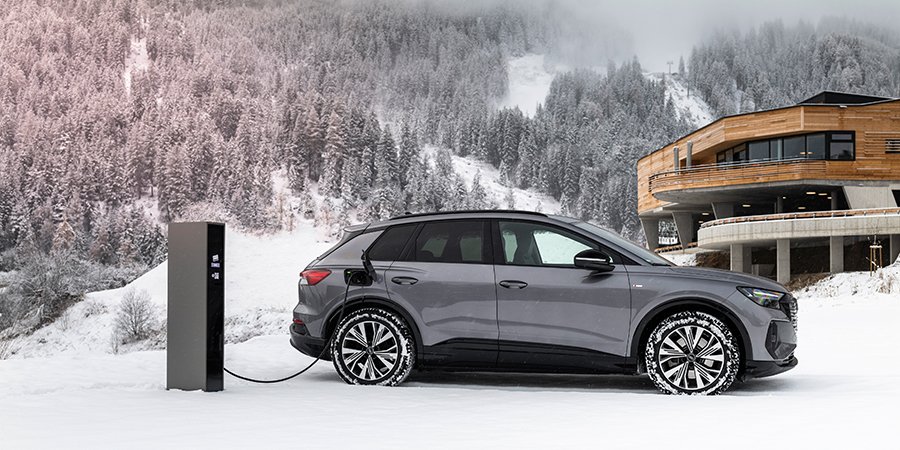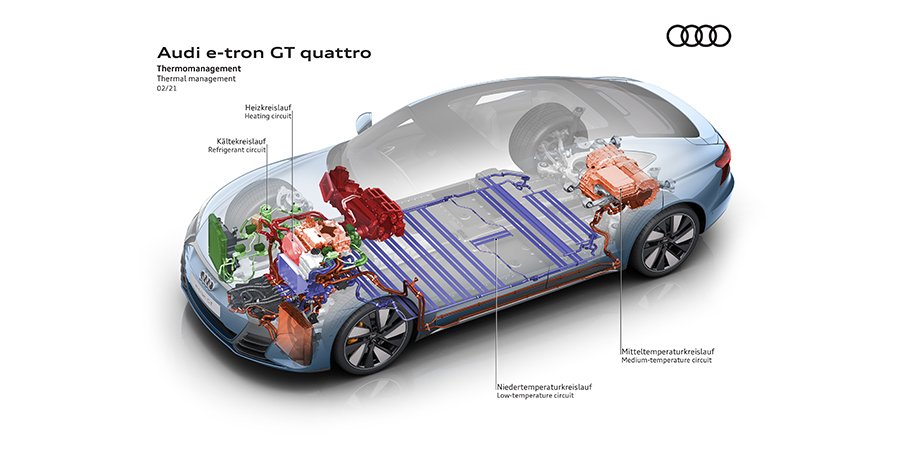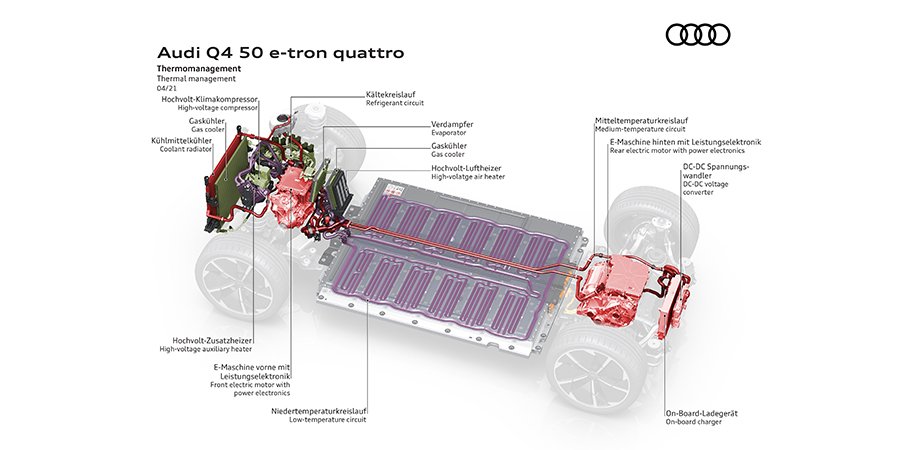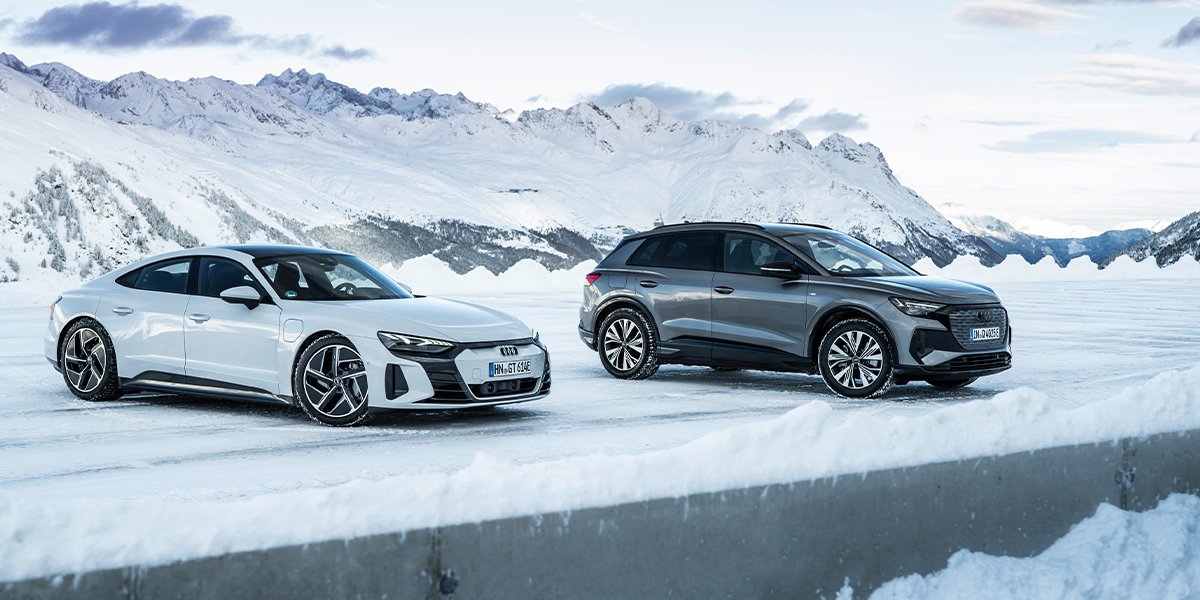Ingolstadt, December 15, 2021 – In winter, electric vehicles must bring the interior and battery systems to the right temperature. This dual task requires a lot of energy from them. Excessively cold outside temperatures exacerbate the problem — and impair the performance of high-voltage batteries. Still, concerns about loss of range in electric Audi models are unfounded: thanks to intelligent thermal management, the brand ensures its cars have excellent drivability and range; special protection mechanisms ensure long battery life. In an interview, Pierre Woltmann, Head of Thermal Management for High Voltage Batteries at Audi, and Thomas Anzenberger, Virtual Functional Development Thermal Management, explain how a company with four rings can effectively meet the challenges of winter operation.
Do drivers of electric Audi models need to be concerned about limitations in the winter?
Thomas Anzenberger: I can answer this question with a resounding “no”. The sheer size of our high-voltage batteries means there’s no reason to doubt their performance and range in winter. Our intelligent thermal management always chooses the most efficient method to properly heat the battery and interior in winter. Therefore, if our customers pre-prepare each season with so-called AC charging stations or wall boxes at home, the lifespan of high-voltage batteries will be very long. This feature is especially useful in winter. It protects the battery while minimizing loss of range because the battery is already in its optimal temperature range so it doesn’t have to heat up too much.

How does the cold affect a high-voltage battery?
Pierre Woltmann: The performance of high-voltage batteries is fundamentally dependent on the state of charge and temperature. The colder the weather, the less power the battery can provide. Electrochemical processes contribute to this. At cold battery temperatures, the internal resistance of the battery increases and the usable capacity decreases. We save the battery by releasing less current at lower temperatures. In addition, the battery can absorb waste heat from liquid-cooled high-voltage components such as power electronics, drive systems and chargers, and be directly heated by a coolant heater.
What are the effects of cold on charging?
Woltmann: If the battery temperature is low, the charging process may take longer. For this reason, the battery must be heated during charging, preferably while charging. When connected to a charging station, the vehicle automatically communicates with the power source. Therefore, the charging station knows how much power the battery can draw at any given time. That’s how we make sure the battery doesn’t get overloaded. When charging, the battery draws the power it needs for heating from the charging station.

What is the job of thermal management?
Thomas Anzenberger: Basically, thermal management is responsible for the heat flow distribution between the driver, the high voltage battery and the interior. In this regard in particular, our heat pump systems have proven themselves. It converts energy from the powertrain or ambient air. This is the amount of heat available for battery use, or for internal use in winter. The use of ambient air as an energy source is relatively new: we use it to compensate for the reduced waste heat from the drivetrain, which works more and more efficiently. This gives us access to two separate systems from the powertrain and ambient air, which we use to heat the interior and the high-voltage battery.
How is the temperature of the battery and the interior regulated while driving?
Anzenberger: To ensure reliable heat supply even in very cold temperatures, our heat pump systems are installed in most of our electric models, integrating an additional high pressure heater into the operating concept. This ensures a comfortable interior even in extreme situations and quickly establishes an ideal battery temperature of around 25 to 30 degrees Celsius for optimal performance. For particularly cold northern countries, a second electric heater is available in our winter package. Some models also have the option of additional heating for the e-bike.
Woltmann: When our customers want to drive at peak efficiency in cold outdoor temperatures, thermal management algorithms heat the battery to a lower temperature, releasing less drive power while increasing the vehicle’s range.

What additional technical solutions has Audi developed to make the high-voltage battery independent of the effects of temperature?
Woltmann: As an interface to thermal management, we offer so-called preconditioning, which has a positive effect on both the battery and the interior. The exact departure time can be set via the loading and departure timer – directly in the vehicle or using the myAudi app. As a result, the automatic charging process charges the battery to a preset level and a favorable temperature as close as possible to the departure time. This significantly reduces the loss of range due to battery heating. In addition, pre-air conditioning adjusts the interior temperature to the desired level before departure.
Anzenberger: In the e-tron GT quattro and RS e-tron GT, the regulation of the charging process even works automatically while driving, in order to achieve a consistently high charging capacity at fast charging stations (ie when using the e-tron route planner there) role model. Based on the outside air temperature, the intelligent thermal management system places the battery within the optimal charging temperature range, in addition to preconditioning while driving and before charging begins. This additional mobile preconditioning of the batteries in the e-tron GT quattro and RS e-tron GT ensures the best and fastest charging results.
How does Audi reduce range loss by heating the interior?
Woltmann: Compared to internal combustion engines, electric vehicles have far less waste heat and energy available for heating. Heat generated by batteries, electric motors and power electronics can be conducted to the interior by means of heat pumps. Basically, a heat pump works like a refrigerator – just the other way around. The more waste heat is available, the more efficiently the pump can work. At its best, it can generate up to three kilowatts of heat output from one kilowatt of electricity. This technology is very useful, especially in winter, because it replaces thermoelectric heating elements. Depending on the outside temperature, a heat pump can achieve a larger range than conventional heating.

What can customers who don’t have a garage available do?
Woltmann: If you need a larger range when entering, you should do the prerequisites. Ideally this should be done with AC charging, which is usually more efficient than DC charging because there is less power loss due to the lower current. AC charging is also gentler as it puts less stress on the battery. With AC charging, less current flows. The battery can absorb this even when the battery temperature is very cold, which means the battery doesn’t have to be heated as much. Whether it’s AC or DC, use the departure timer to charge immediately before the journey begins to use a higher battery temperature for increased range, or immediately after the journey ends for a faster and more efficient charge .
What happens to a cold battery at a fast-charging station?
Woltmann: Regardless of the model, algorithms in the vehicle recognize when the car is charging at a DC fast-charging station. Current is delivered regardless of state of charge and temperature. With the active heating we implemented, we significantly reduced the charging time at low temperatures.
When do high-voltage batteries reach their limit?
Woltmann: To protect the battery, we no longer emit any energy from a core temperature of -30 degrees. To do this, however, the car would have to be exposed to such extreme temperatures for extended periods of time. Of course, it is also possible to drive e-tron models with fully charged and preheated high-voltage batteries in an outdoor temperature of minus 30 degrees.
From a technical perspective, what additional advice can you give for the winter?
Anzenberger: By using the on-board computer and the mileage monitor in Audi MMI with mileage prediction while driving, customers can see directly how much mileage they will get if the temperature inside the car cools. The range can be increased by the range mode. As a result, comfort functions, drive power and top speed are slightly limited.

